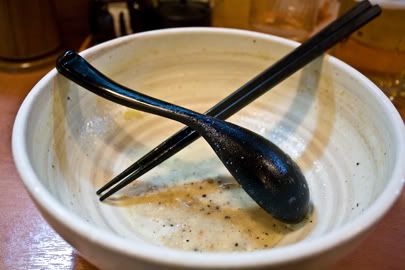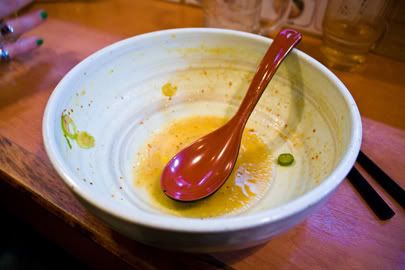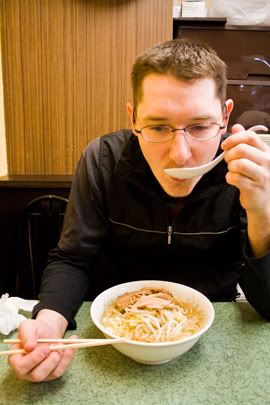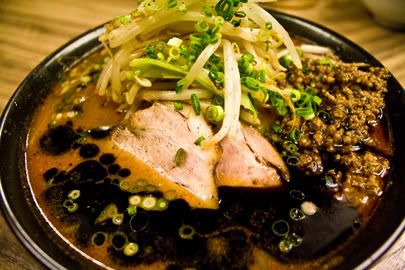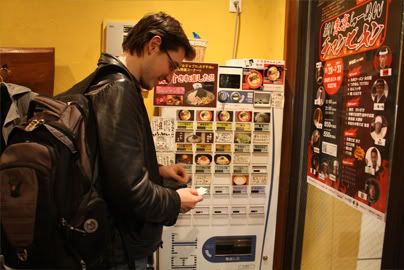
Outside the restaurant is a huge sign listing all the various ramen and tsukemen the shop offers. By 9pm the place gets pretty full so don't be surprised by a small wait. The shop has about four or five booths and a long bar at which to eat. Micah and I were sat at the bar and given an extensive noodle and drink menu to peruse. I decided on the Eizou ramen and Micah chose the yakimiso ramen. The server will ask how you want your noodles prepared, Micah and I both chose "futsu" or medium. In less than 10 minutes two piping hot bowls of ramen were placed before us.
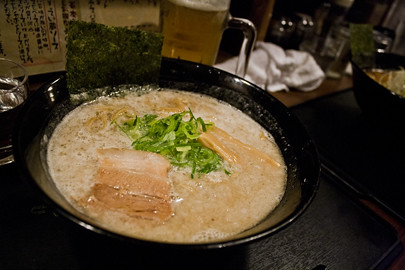
The Eizou ramen
The Eizou ramen was a tonkotsu broth with thick wavy noodles, definitely thicker than your average noodle, very similar to the noodles at Nantsuttei. The broth was hearty and very fatty. Included were two slices of chashu, two thick shoots of menma (bamboo), a sheet of nori (seaweed) and topped with a handful of chopped negi (spring onion.) It was definitely a very tasty bowl of ramen and I'd love to eat it again some time! By the time I was finishing the noodles, I was becoming quite full, this bowl of ramen really fills you up! There was no possible way I could finish the broth due to its fatty nature. Micah says the soup reminded him a lot of Ichiran's ramen. I haven't eaten at Ichiran in a couple years so I can't confirm that. All I know is that is was a nice bowl of ramen. Not the best I've ever eaten, but certainly far from the worse!
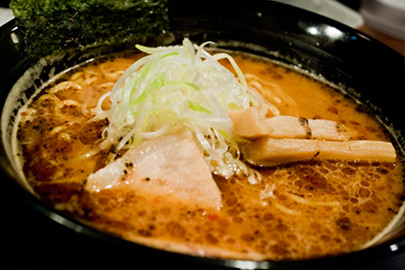
The yakimiso ramen
Micah enjoyed this yakimiso ramen. Don't let the photo fool you, despite the red coloring it wasn't very spicy. It had a peppery spiciness to it, but it wasn't terribly spicy. It came with the same fixings as the Eizou ramen, which I guess is probably standard at this shop. Micah says this ramen was oily, as opposed to my fatty ramen. The noodles were thinner than the ones in mine and they were soft but they retained their shape nicely. Overall, a nice solid ramen, good, not especially unique but very well made and very well proportioned.

Nihonshu labels on the wall
An interesting thing about this shop is the sheer variety of nihonshu (Japanese alcohol) offered. They have your standard ramen shop drinks such as draft beer, but there was also a lot of shochu and sake available as well. In the drink menu is a map of Japan with a list of available sake from different regions of Japan. It was my first time encountering such a variety of alcohol at a ramen shop, which makes this shop a bit unique.
Overall, the ramen was tasty and well priced. It's not incredibly unique, but if you're hankering for a bowl of something good, this place will leave you satisfied.
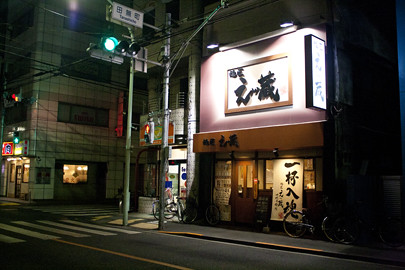
Menshou Eizou
3-9-23 Tanashicho
Nishitokyo, Tokyo
188-0011
42-461-3306






